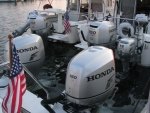I have often read how many boaters think the wind and the tides/currents are something to "fight". And I have also heard another approach from boaters who generally came from a slower sailing or human powered background. Their opinion of wind and current is quite different. They see it as an opportunity to gain advantage and speed, to cut a passage time in half or something to avoid if the details are not in their favor and relish the time spent while conditions improve.
If it's 1pm on a Sunday and you still have some distance to cover back to the launch and now your main is acting up, its a stressful situation for most. Being able to start another motor and keep doing what your used to is exactly what we lean toward first. After all, you should be back at work tomorrow and your were hoping to eat at that restaurant on the way home and there are a few chores at home you were hoping to complete before hitting the hay.
Starting up a 10hp outboard and going the direction you want, right now, at a speed that still gives a sensation of power and control is exactly what people want at that time and I have done exactly that myself with twins and it is satisfying. But was it necessary?
When discussing backup power for a boat and the obvious trend toward lightening the load and minimizing the power requirement, we are really discussing a safety threshold. How much power does a person need to keep safe in their boat. We don't all have gobs of time, but pushing, hurrying, and fighting is often what gets people into trouble in the first place and often what makes it worse. Even with a large kicker, you may not have enough time to make it back to the launch that day.
There are some local/use factors that may change the game for some, but I find a C-dory to be a very safe boat even un-powered. At least in the WA/BC region, it doesn't take much thrust to keep a boat away from rocky shores if you are willing (for the sake of safety) to go WITH the wind or current using limited power to sometimes steer more than drive and look out for that cove or beach or bay around the next bend. Once you reach this safe place, you can evaluate the problem and come up with an approach to a solution. I know fixing broken stuff is not everyone's idea of a good time but if you maintain your motor well, and run it with some level of skill and attention, it will not put you in a bind with any frequency.
I know we are a power boating group with a general lean toward speed (I like it too), but I think it's wise to remember the other side. If you limit your exposure and stay out of big, open water in poor conditions, I think it is perfectly acceptable to put a very small kicker on the back of even a Tomcat to provide you with some movement and steerage to get you to a safer place to address any issues that occur, or just to putt along and enjoy the scenery.
If you have not taken the time to putt-putt your boat at 3mph for a few hours and notice how well you do actually cover water, I would encourage you to do just that and realize that moving slowly is still moving and it doesn't take speed to be safe. It takes good judgement and sometimes patience as well.
Not coincidently, I am leaving tonight to lead a west coast Vancouver island four day off shore kayaking trip travelling at 3-4mph safely in conditions I might not enjoy in my C-Dory. Don't fight it, ride it.



